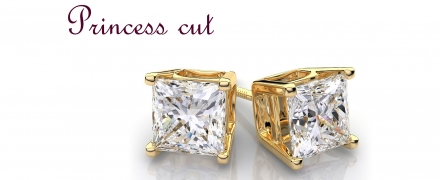open 10 am - 7 pm
laboratory is closed
The long journey of the "Princess"

The modern princess brilliant cut was developed and introduced between 1979-1981. Cutting designers include names such as Ygal Perlman, Betzalel Ambar and Israel Itzkowitz, with the latter being prioritized in the final design of the cut. Despite the fact that the "princess" cut was created quite recently, its roots go back to the late 14th - early 15th centuries, when a rectangular cut with a diagonal arrangement of the main facets of the crown was made, which was called "French star" or simply "French". In the 1950s-1960s, a number of sophisticated French cut varieties were created. These cuts, the immediate predecessors of the modern princess, include Basil Watermeyer's cut from South Africa. It was developed in 1971 and named "Barion" after the name of his wife - Marion. This cut combines two types of pavilion facets - stepped and wedge-shaped. In the early 1960s, the princess was called the cut, now known as the "profile" cut, originally developed by Arpad Nagy specifically for flake diamonds. The "profile" cut is usually made in the shape of a heart, which allows it to be used as part of a set when drawing up any ornament. The modern princess cut requires very careful handling when setting into jewelry, as the cut corners can be subject to chipping defects. This feature determined the further development of the "princess" cut and the appearance of the "radiant" cut, characterized by beveled corners and, due to this, having a greater number of facets.
В геммологической практике бывают весьма увлекательные случаи с диагностикой ювелирных вставок
Но помимо редкости цвета и высокой стоимости таких камней, многие розовые камни выделяются одной замечательной особенностью – они проявляют плеохроизм, то есть в зависимости от положения осмотра камня он может иметь дополнительные оттенки – оранжевый или пурпурный.
Currently, gemstones are produced by two fundamentally different technological methods - the High Pressure - High Temperature method (“HPHT”, High-pressure & High-temperature) and the Chemical Vapor Deposition (“CVD”, Chemical vapor deposition) method. The "HPHT" method is the most tested classical synthesis method, which can be used both carbon deposition on diamond from flux melts and catalytic reactions. In "CVD" synthesis, diamond growth occurs on a seed during carbon deposition mainly from a gaseous medium at relatively low temperatures and pressures.
Jewelry and precious stones are just such a category of goods, when buying which you need to pay attention to many criteria.
Sogdianite is a rather rare mineral and more often it can be found as a collection material (moreover, in systematic collections), and it is extremely rare in jewelry.






